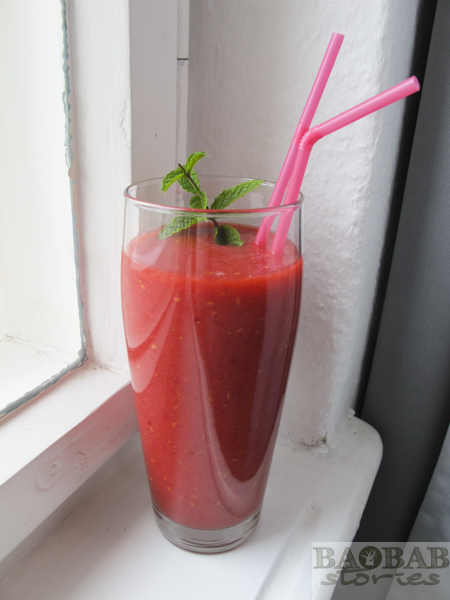Baobabs are trees growing in sub-Saharan Africa – usually in dry areas such as savannas and African forests. They bloom during the rainy season which starts in Southern Africa in late November, early December. The fruit take about six months to ripen on the tree. First, they are yellowish and later on during the ripening process change color to brownish – olive green. The fruit become up to 50 cm long and about 20 cm wide. Thanks to the fine hair the surface of the fruit feels velvety.
Baobab fruit have a very hard shell those of Zanzibar even up to 10 millimeters. It protects the valuable fruit powder and the seeds. The fruit powder inside the fruit is known as pulp and starts out wet. It dries during the ripening process in the shell as long as the fruit are still hanging on the trees. Once the fruit are ripe, they fall to the ground. Smallholders collect the fruit and sell them on local markets or nowadays directly to producers. Since baobab fruit do not grow on plantations and are not produced by agriculture they are called wild fruit collections.
During processing, the fruit are opened. The pulp is taken out and cleaned of fibers and seeds by mechanical sieving. The fibers and seeds are embedded in the pulp. Additional processing steps are usually not necessary, because the powder is naturally dried, packaged and ready for sale. Thus, it maintains its high levels of valuable ingredients.
What is so special about the fruit?
Their diverse combination of ingredients makes baobab fruit special. It is traded internationally as a “super fruit” like Goji berries or Acai berries and it enjoys growing popularity.
Baobab fruit contain about six times more Vitamin C than oranges, up to ten times as much fiber as apples, more antioxidants than blueberries, more magnesium than avocados, more potassium than bananas, more calcium than milk and more iron than meat. This outstanding mix also includes B vitamins and different omega fatty acids. The concentration of the ingredients may vary depending on the origin of the powder.
How do I use baobab powder in everyday life?
Baobab powder has a sherbety taste a bit like a mixture of apple and lime or lemon. Two teaspoons of the powder adds a fresh touch to drinks, smoothies, cereals and desserts. It tastes delicious in curries and other dishes that are traditionally flavored with lime or lemon.
Since Baobab powder is a natural food, there is no exact formula on how much should be consumed them per day. Eco Products, a manufacturer of Baobab powder from South Africa, recommends the use of two tablespoons (about 12 grams) per day for optimal results. The body benefits from about 17.4 milligrams of magnesium, 24 milligrams of vitamin C, 48 milligrams of calcium, 264 milligrams of potassium and 6 grams of fiber.
A Dream in Red – A Baobab Recipe:
150-200 gr raspberries
150 gr strawberries
2 teaspoons Baobab powder
50ml apple juice
100 ml of water
½ banana
Preparation:
• Cut the banana into pieces
• Put raspberry, strawberry, baobab powder and lemon juice in a blender
• Add banana, apple juice and water, mix everything
For those who like it sweet: add 2 teaspoons agave syrup and mix well.






Pingback: Baobab deco - beautiful and useful - Baobab
Please identify Baobab Powder stockists in Port Elizabeth
Hi Andrew, please check with http://www.ecoproducts.co.za they are a reliable source of baobab powder and may have a shop in your area. Kind regards, Heike
Dear sirs. I have heard that Baobab powder is a real alkalizer and yet,when I check the P. H. Level of the powder in water, it is off the scale acid! Can you please enlighten me on this aspect. Alkalinity is extremely important to me at this time. What colour should the dry powder be. We are able to get a slightly beige powder. Many thanks Rob
Dear Robert, thank you for getting in touch. I know that baobab powder is an alkalizer but to make sure you get the correct answer I contacted a friend who is an expert in that sector. I am waiting for her to respond and will get back to you asap. With respect to the colour of the powder: fresh powder (that I have seen so far) usually comes in a whitish colour (slightly beige) and turns a bit more yellow-ish once it gets older. But one should take into consideration the kind of soil the tree grew in and the nutrients it consumed – that may have an impact on the colour of the fruit powder. Hope that helps, kind regards, Heike
Dear Robert Glen, thank you again for asking and for your patience. I could not get an answer to your question – sorry. All the best, Heike